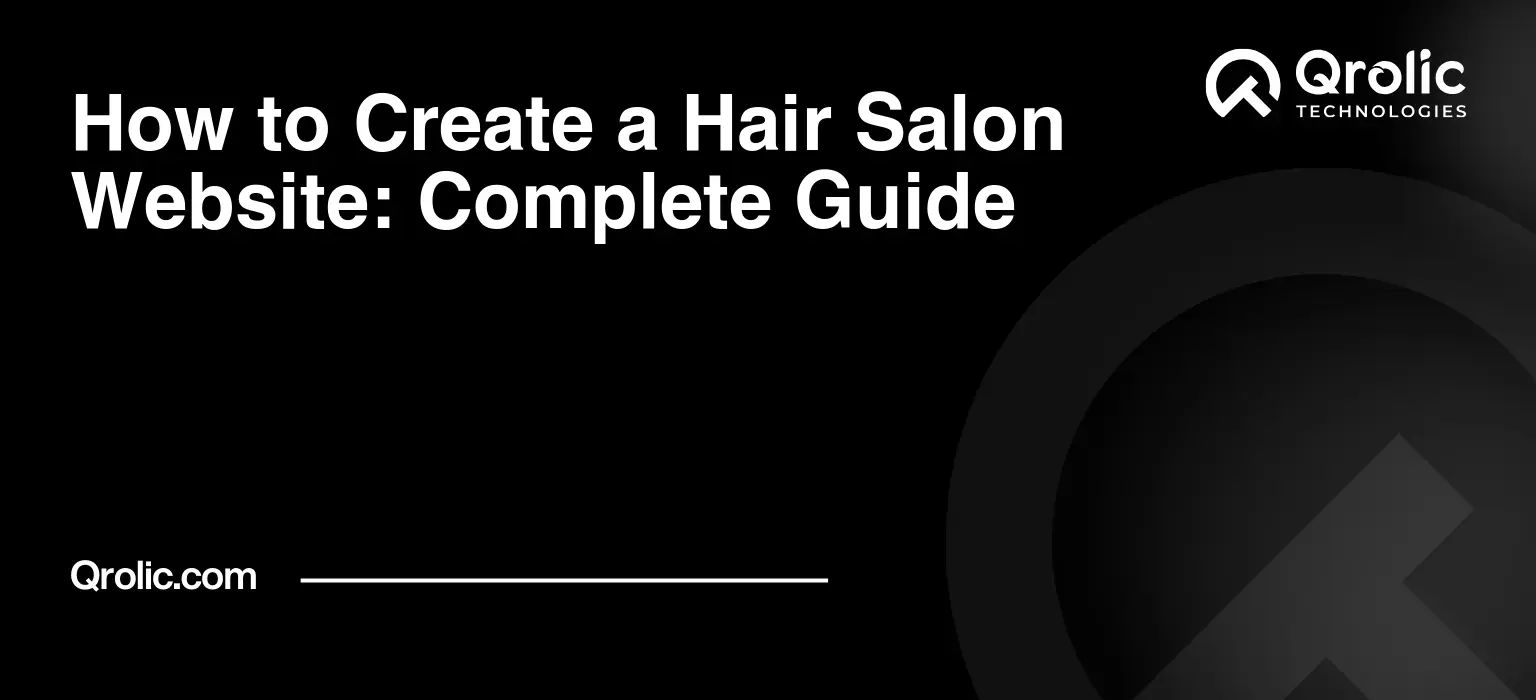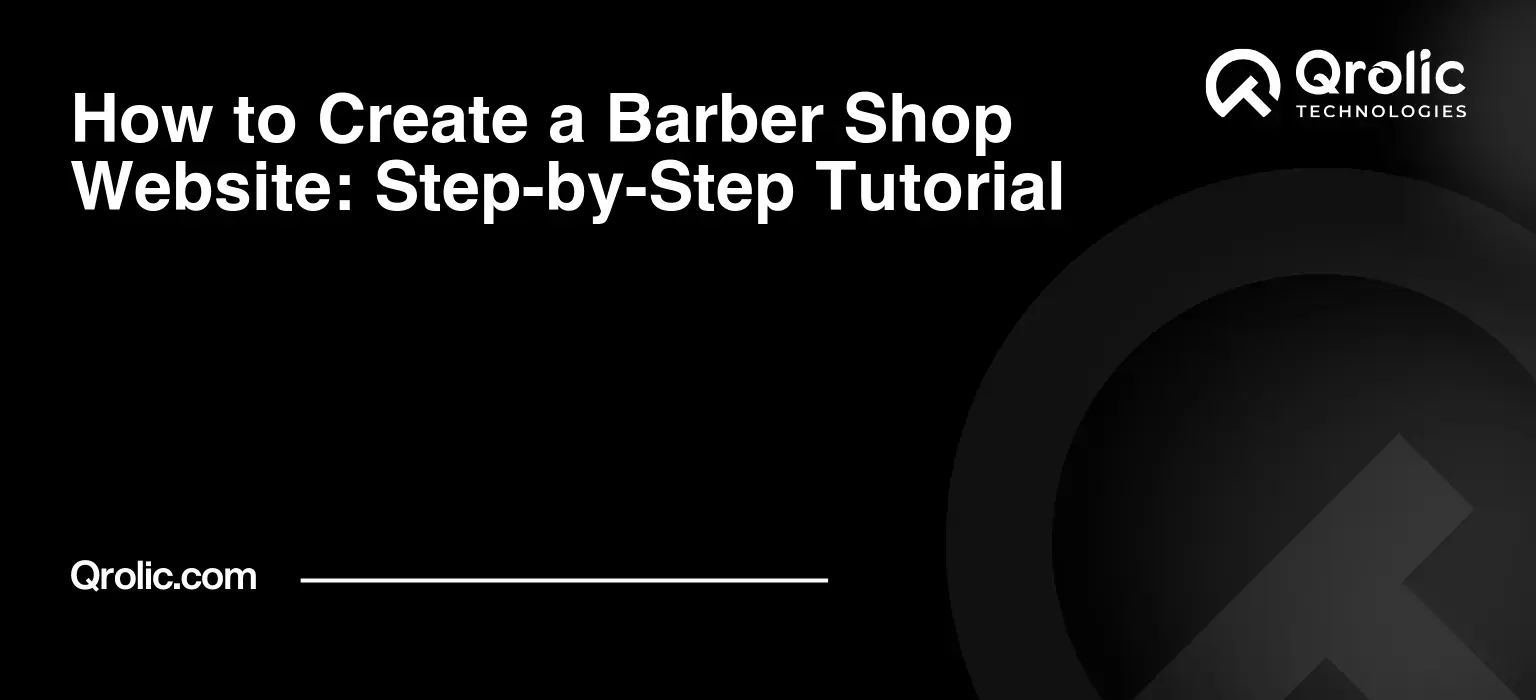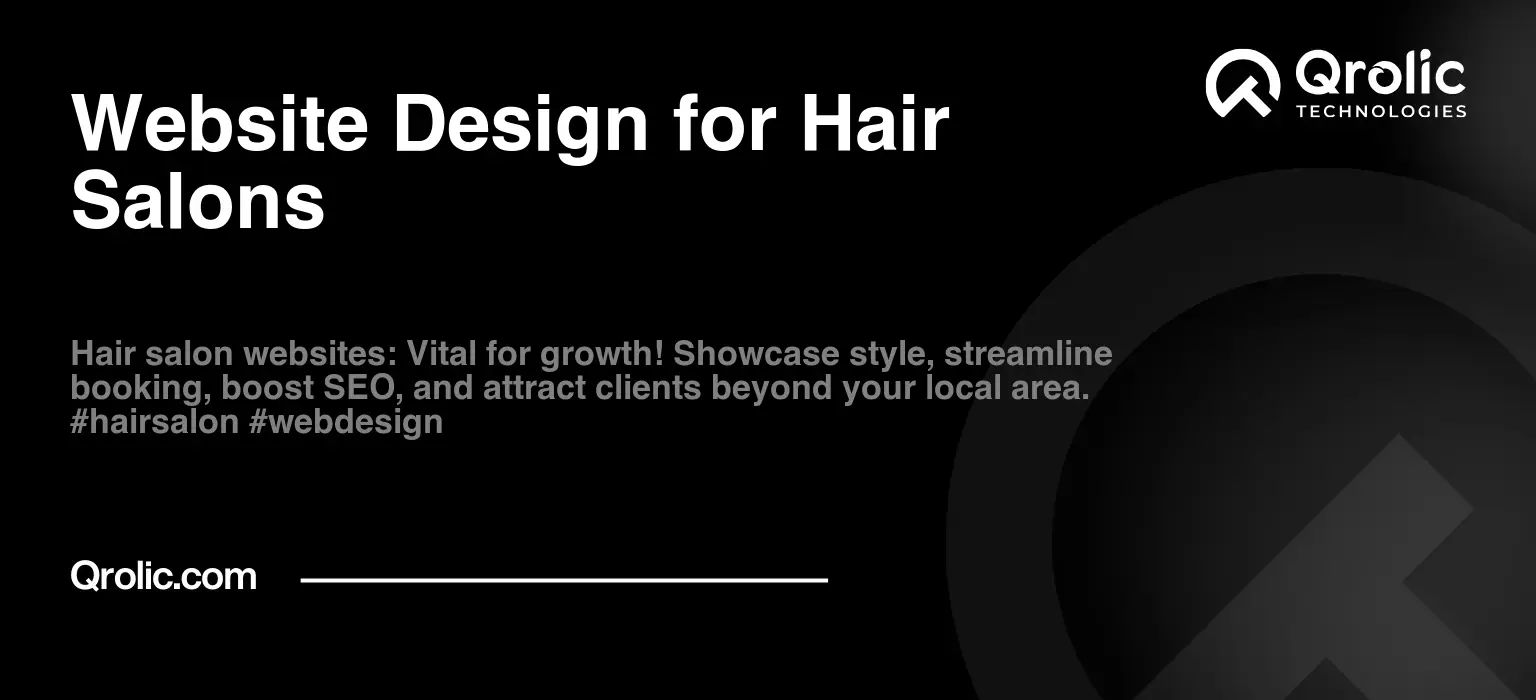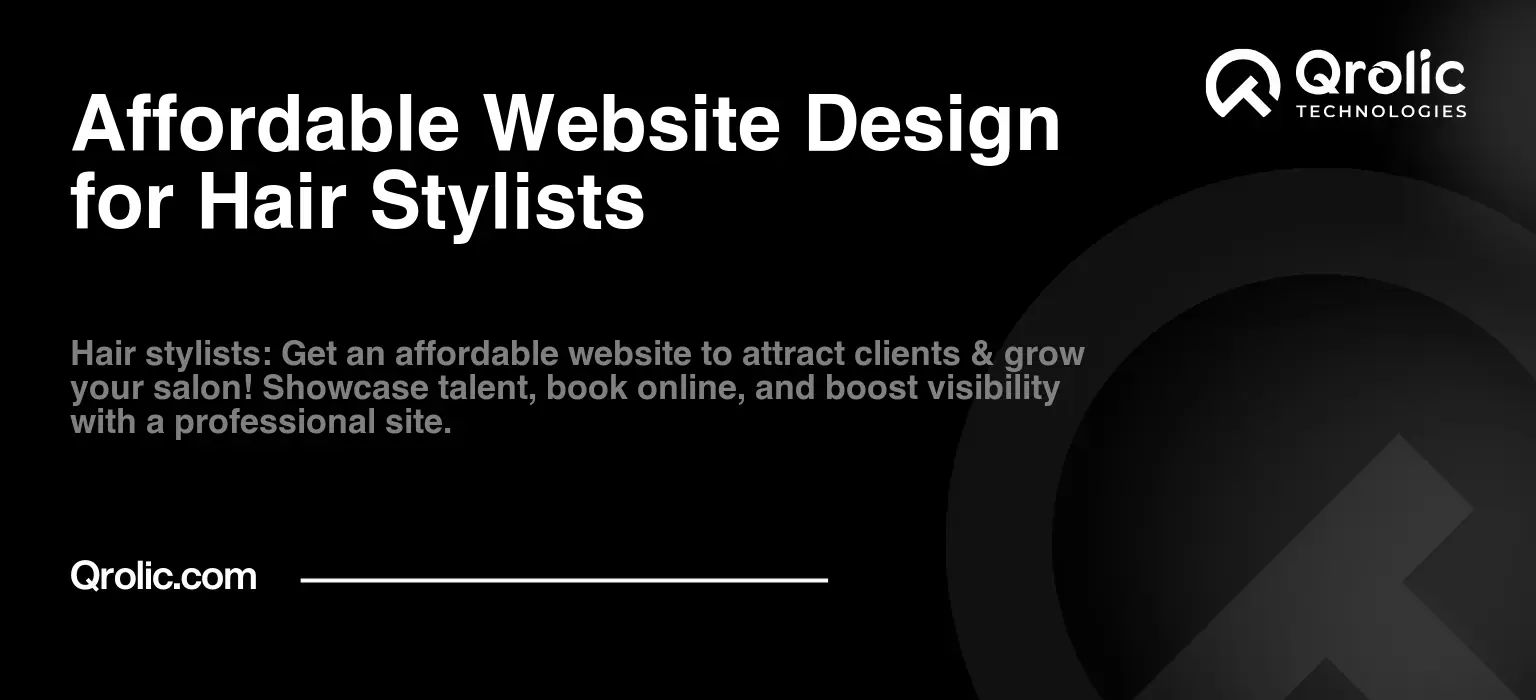Quick Summary:
- A website is vital for salon visibility and attracting clients.
- Plan, design, and create engaging content for your site.
- Add online booking, optimize for SEO, and market it.
Table of Contents
- How to Create a Hair Salon Website: Complete Guide
- Why Your Hair Salon Needs a Website: Cutting Through the Clutter
- Planning Your Hair Salon Website: Laying the Foundation for Success
- Choosing the Right Platform: Building on Solid Ground
- Designing Your Hair Salon Website: Creating a Visually Appealing Experience
- Content Creation for Your Hair Salon Website: Engaging and Informative
- Integrating Online Booking: Streamlining the Appointment Process
- SEO for Hair Salons: Getting Found Online
- Marketing Your Hair Salon Website: Driving Traffic and Generating Leads
- Maintaining and Updating Your Hair Salon Website: Keeping it Fresh and Relevant
- How Qrolic Technologies Can Help Your Hair Salon Website Succeed
- Conclusion: Styling Your Way to Success Online
How to Create a Hair Salon Website: Complete Guide
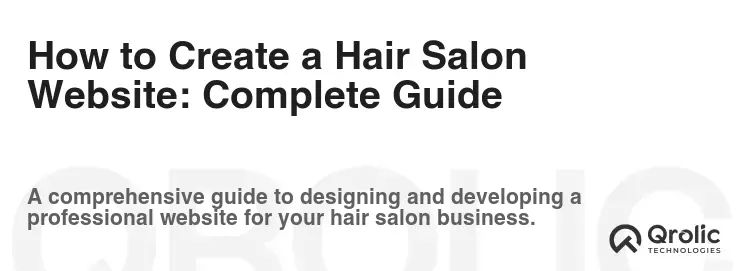
Why Your Hair Salon Needs a Website: Cutting Through the Clutter
In today’s digital age, a website isn’t a luxury; it’s a necessity. For a hair salon, it’s your virtual storefront, a 24/7 marketing tool, and a crucial element in attracting and retaining clients. Think of it as your online receptionist, stylist, and sales team all rolled into one.
Beyond the Business Card:
- Increased Visibility: A website puts your salon on the map for potential clients searching online for “hair salon near me,” “best haircuts in [city],” or specific services like “balayage specialist.” Without a website, you’re invisible to a large segment of the population actively seeking what you offer.
- Building Trust and Credibility: A professionally designed website instantly builds trust. It showcases your expertise, allows you to display client testimonials and reviews, and reinforces your brand’s identity.
- Showcasing Your Talent: A picture is worth a thousand words. A website allows you to create a stunning portfolio of your best work, demonstrating your skill and artistry to potential clients. Before-and-after photos, style galleries, and videos of your stylists in action can be incredibly persuasive.
- Simplified Booking and Management: Online booking systems integrated into your website streamline the appointment process, making it easier for clients to schedule services and freeing up your staff to focus on providing excellent service.
- Detailed Service Information: Provide comprehensive details about the services you offer, including descriptions, pricing, and duration. This transparency helps clients make informed decisions and reduces phone calls with inquiries.
- Direct Communication: A website allows you to communicate directly with your clients through contact forms, email newsletters, and even live chat. This fosters stronger relationships and allows you to address concerns promptly.
- Competitive Advantage: In a competitive market, a well-designed website can set you apart from the competition. It demonstrates your commitment to innovation and customer service.
- Cost-Effective Marketing: Compared to traditional advertising methods, a website can be a more cost-effective marketing tool, especially when combined with search engine optimization (SEO) and social media marketing.
- Brand Storytelling: Your website is the perfect place to tell your salon’s story. Share your mission, values, and the passion that drives your team. This helps clients connect with your brand on a deeper level.
Why Now is the Time to Invest:
The beauty industry is booming, and consumers are increasingly turning to the internet to research and book salon services. If you don’t have a website, you’re missing out on a significant opportunity to grow your business.
Planning Your Hair Salon Website: Laying the Foundation for Success
Before you start building your website, it’s crucial to have a solid plan in place. This involves defining your target audience, identifying your goals, and outlining the key features and content you’ll need.
1. Defining Your Target Audience:
- Demographics: Consider the age, gender, income level, and location of your ideal client. Are you targeting students, young professionals, families, or a more mature clientele?
- Lifestyle: What are their interests and hobbies? Are they fashion-conscious, eco-friendly, or budget-conscious?
- Needs and Pain Points: What are they looking for in a hair salon? Are they seeking convenience, expertise, a specific style, or a relaxing experience?
- Example: If you specialize in trendy hairstyles for young professionals in an urban area, your website should reflect that aesthetic. Use modern design elements, showcase edgy hairstyles, and highlight your expertise in the latest trends.
2. Setting Clear Goals:
- Increase Bookings: The primary goal for most salons is to increase the number of appointments booked through their website.
- Generate Leads: Collect contact information from potential clients interested in your services.
- Build Brand Awareness: Establish your salon as a trusted and reputable brand in your local area.
- Showcase Expertise: Demonstrate your stylists’ skills and experience through a portfolio and blog.
- Improve Customer Communication: Provide a convenient way for clients to contact you with questions or concerns.
- Drive Traffic to Your Salon: Encourage clients to visit your physical location.
- Example: A goal might be to increase online bookings by 20% within the next six months.
3. Defining Key Website Features:
- Online Booking System: Essential for allowing clients to schedule appointments online.
- Service Menu with Pricing: Clearly list all the services you offer, along with their prices and descriptions.
- Portfolio/Gallery: Showcase your best work with high-quality photos and videos.
- Stylist Profiles: Introduce your team of stylists and highlight their individual skills and specialties.
- Client Testimonials: Feature positive reviews from satisfied clients to build trust.
- Contact Form and Information: Provide a convenient way for clients to contact you with questions or concerns.
- Blog: Share informative and engaging content about hair care, styling tips, and the latest trends.
- Location and Directions: Make it easy for clients to find your salon.
- FAQ Section: Answer frequently asked questions to save time and reduce phone calls.
- Social Media Integration: Connect your website to your social media profiles to expand your reach.
- Example: For a salon specializing in bridal hairstyles, a dedicated gallery showcasing wedding hair looks would be crucial.
4. Content Planning:
- Homepage: This is the first impression, so make it count. Showcase your best work, highlight your unique selling points, and include a clear call to action (e.g., “Book an Appointment”).
- About Us: Share your salon’s story, mission, and values. Introduce your team and highlight their expertise.
- Services: Provide detailed descriptions of each service you offer, including pricing, duration, and benefits.
- Gallery: Showcase your best work with high-quality photos and videos. Organize your gallery by service type or stylist.
- Stylists: Create individual profiles for each stylist, highlighting their skills, experience, and specialties.
- Testimonials: Feature positive reviews from satisfied clients to build trust.
- Blog: Plan a content calendar with topics relevant to your target audience. Examples include “How to Choose the Right Haircut for Your Face Shape,” “Tips for Maintaining Healthy Hair,” and “The Latest Hair Color Trends.”
- Contact: Provide your salon’s address, phone number, email address, and a contact form.
- Privacy Policy & Terms of Service: Ensure compliance with legal requirements.
5. Keyword Research:
- Identify Relevant Keywords: Use tools like Google Keyword Planner, SEMrush, or Ahrefs to identify keywords that potential clients are using to search for hair salons in your area.
- Long-Tail Keywords: Focus on longer, more specific keywords that target a narrower audience but have a higher conversion rate. Examples include “best balayage salon in [city]” or “affordable haircut for curly hair.”
- Local SEO Keywords: Include your city and neighborhood in your keywords to target local customers.
- Example: Common keywords might include “hair salon,” “haircut,” “hair color,” “balayage,” “highlights,” “hairstylist,” “men’s haircut,” “women’s haircut,” “children’s haircut,” “hair extensions,” “perm,” “relaxer,” “wedding hairstyles,” and “[city] hair salon.”
6. Budget and Timeline:
- Determine Your Budget: How much are you willing to spend on website design, development, and maintenance?
- Set a Realistic Timeline: How long will it take to plan, design, build, and launch your website?
- Factor in Ongoing Costs: Consider ongoing costs such as hosting, domain registration, and website maintenance.
Choosing the Right Platform: Building on Solid Ground
Selecting the right platform for your hair salon website is a crucial decision. Several options are available, each with its own strengths and weaknesses.
1. Website Builders (DIY):
- Examples: Wix, Squarespace, Weebly
- Pros: User-friendly, drag-and-drop interface, affordable, pre-designed templates.
- Cons: Limited customization options, can be less SEO-friendly, less control over website functionality.
- Best For: Salons with limited technical skills and a tight budget. Great for simple, brochure-style websites.
- Considerations:
- Ease of Use: How intuitive is the interface? Can you easily add content and customize the design?
- Templates: Do they offer templates specifically designed for hair salons?
- SEO Features: Do they provide tools for optimizing your website for search engines?
- eCommerce Functionality: Can you sell products or gift certificates online?
- App Integrations: Do they integrate with appointment scheduling apps, email marketing services, and social media platforms?
- Mobile Responsiveness: Is your website automatically optimized for mobile devices?
- Wix: Offers a wide range of templates and a user-friendly drag-and-drop interface. However, it can be less SEO-friendly than wordpress.
- Squarespace: Known for its beautiful templates and clean design. A good option for salons that prioritize aesthetics.
2. Content Management Systems (CMS):
- Example: WordPress
- Pros: Highly customizable, SEO-friendly, extensive plugin library, greater control over website functionality.
- Cons: Requires more technical skills, can be more expensive than website builders.
- Best For: Salons that want a highly customized website with advanced features and strong SEO performance.
- Considerations:
- Themes: Choose a theme specifically designed for hair salons.
- Plugins: Use plugins to add features such as online booking, appointment scheduling, and social media integration.
- SEO: Optimize your website for search engines using SEO plugins like Yoast SEO or Rank Math.
- Security: Implement security measures to protect your website from hackers and malware.
- WordPress.org (Self-Hosted): Requires you to find your own hosting provider and manage your website’s security and updates. Offers the most flexibility and control.
- WordPress.com: A hosted platform that offers a simpler setup but with limited customization options.
3. Custom Website Development:
- Pros: Completely customized to your specific needs, unique design, maximum control over functionality.
- Cons: Most expensive option, requires hiring a professional web developer.
- Best For: Salons with a large budget and complex requirements.
- Considerations:
- Portfolio: Review the developer’s portfolio to ensure they have experience building websites for hair salons.
- Communication: Establish clear communication channels with the developer.
- Timeline: Set a realistic timeline for the project.
- Maintenance: Discuss ongoing website maintenance and support.
Choosing the Right Option:
Consider your budget, technical skills, and desired level of customization when choosing a platform. If you’re just starting out and have limited technical skills, a website builder like Wix or Squarespace may be a good option. If you want a highly customized website with advanced features and strong SEO performance, WordPress is a better choice. If you have a large budget and complex requirements, custom website development may be the best option.
Designing Your Hair Salon Website: Creating a Visually Appealing Experience
The design of your hair salon website is crucial for attracting and retaining clients. It should be visually appealing, easy to navigate, and reflect your brand’s identity.
1. Branding and Visual Identity:
- Logo: Use your logo prominently on your website.
- Color Palette: Choose a color palette that reflects your brand’s personality and appeals to your target audience.
- Typography: Select fonts that are easy to read and consistent with your brand’s style.
- Imagery: Use high-quality photos and videos that showcase your best work.
- Consistency: Maintain a consistent look and feel throughout your website.
2. Website Layout and Navigation:
- Clear Navigation: Make it easy for visitors to find what they’re looking for. Use a simple and intuitive navigation menu.
- Homepage Design: Showcase your best work, highlight your unique selling points, and include a clear call to action.
- Mobile-Responsive Design: Ensure your website is optimized for mobile devices.
- User-Friendly Design: Make your website easy to use and navigate.
- Whitespace: Use whitespace to create a clean and uncluttered design.
- Call to Actions (CTAs): Use clear and compelling CTAs to encourage visitors to take action (e.g., “Book an Appointment,” “Schedule a Consultation,” “View Our Services”).
3. High-Quality Imagery and Videos:
- Professional Photography: Invest in professional photography to showcase your best work.
- Before-and-After Photos: Show the transformation you can achieve for your clients.
- Stylist Portraits: Include photos of your stylists to personalize your website.
- Salon Interior: Showcase the ambiance and atmosphere of your salon.
- Videos: Create videos that showcase your services, stylists, and client testimonials.
4. Mobile-First Approach:
- Mobile-Responsive Design: Ensure your website is optimized for mobile devices.
- Mobile-Friendly Navigation: Make it easy for mobile users to navigate your website.
- Fast Loading Speed: Optimize your website for fast loading speed on mobile devices.
5. Accessibility:
- Alt Text: Add alt text to all images to improve accessibility for users with visual impairments.
- Color Contrast: Ensure sufficient color contrast between text and background.
- Keyboard Navigation: Make sure your website can be navigated using a keyboard.
6. Website Design Tips:
- Keep it Simple: Avoid clutter and focus on essential information.
- Use High-Quality Images: Invest in professional photography to showcase your best work.
- Choose a Consistent Color Palette: Use a color palette that reflects your brand’s personality.
- Use Clear and Concise Language: Make it easy for visitors to understand your services and offerings.
- Test Your Website: Test your website on different devices and browsers to ensure it looks and functions properly.
Content Creation for Your Hair Salon Website: Engaging and Informative
High-quality content is essential for attracting and retaining clients. It should be informative, engaging, and optimized for search engines.
1. Service Descriptions:
- Detailed Descriptions: Provide detailed descriptions of each service you offer, including pricing, duration, and benefits.
- Target Keywords: Include relevant keywords in your service descriptions to improve your website’s search engine ranking.
- Highlight Unique Selling Points: Emphasize what makes your services unique and better than the competition.
- Use Clear and Concise Language: Make it easy for visitors to understand your services and offerings.
2. Stylist Biographies:
- Professional Photos: Include professional photos of your stylists.
- Highlight Skills and Expertise: Describe each stylist’s skills, experience, and specialties.
- Personalize the Biographies: Share personal details about each stylist to help clients connect with them.
- Include Social Media Links: Link to each stylist’s social media profiles.
3. Blog Content:
- Relevant Topics: Choose topics that are relevant to your target audience and address their needs and interests.
- Informative and Engaging: Create content that is informative, engaging, and provides value to your readers.
- SEO Optimization: Optimize your blog posts for search engines by including relevant keywords in the title, headings, and body of the text.
- Call to Action: Include a call to action at the end of each blog post to encourage visitors to take the next step (e.g., “Book an Appointment,” “Subscribe to Our Newsletter”).
4. Client Testimonials:
- Gather Positive Reviews: Collect positive reviews from satisfied clients.
- Feature Real Testimonials: Use real testimonials from real clients to build trust.
- Include Photos: Include photos of the clients who provided the testimonials.
- Display Prominently: Display testimonials prominently on your website.
5. FAQ Section:
- Answer Common Questions: Answer frequently asked questions about your services, pricing, and policies.
- Save Time and Reduce Phone Calls: Provide answers to common questions to save time and reduce phone calls.
- Improve Customer Service: Provide helpful information to improve customer service.
6. Website Content Tips:
- Know Your Audience: Write content that is tailored to your target audience.
- Use Clear and Concise Language: Make it easy for visitors to understand your services and offerings.
- Optimize for SEO: Use relevant keywords to improve your website’s search engine ranking.
- Proofread Carefully: Proofread your content carefully to ensure it is free of errors.
- Update Regularly: Keep your content fresh and up-to-date.
Integrating Online Booking: Streamlining the Appointment Process
Integrating an online booking system into your hair salon website can streamline the appointment process, making it easier for clients to schedule services and freeing up your staff to focus on providing excellent service.
1. Benefits of Online Booking:
- 24/7 Availability: Clients can book appointments anytime, anywhere.
- Increased Bookings: Online booking can increase the number of appointments booked through your website.
- Reduced Phone Calls: Online booking can reduce the number of phone calls you receive.
- Improved Customer Service: Online booking provides a convenient way for clients to schedule appointments.
- Automated Reminders: Automated appointment reminders can reduce no-shows.
2. Choosing an Online Booking System:
- Ease of Use: Choose a system that is easy to use for both clients and staff.
- Features: Consider the features you need, such as appointment scheduling, payment processing, and automated reminders.
- Integration: Make sure the system integrates with your website and other business tools.
- Pricing: Compare the pricing of different systems.
- Reviews: Read reviews from other salon owners to get an idea of their experiences with different systems.
3. Popular Online Booking Systems:
- Acuity Scheduling: A popular option with a wide range of features, including appointment scheduling, payment processing, and automated reminders.
- Booksy: A mobile-first platform that is popular with salons and barbershops.
- Square Appointments: A free option for businesses that use Square for payment processing.
- Timely: A comprehensive salon management software with online booking capabilities.
- Vagaro: A popular option with a wide range of features, including appointment scheduling, point of sale, and marketing tools.
4. Integrating the Booking System:
- Embed Code: Most online booking systems provide an embed code that you can use to integrate the system into your website.
- Plugin: If you are using WordPress, you can use a plugin to integrate the booking system.
- Custom Integration: If you need a more customized integration, you can hire a web developer to help you.
5. Promoting Online Booking:
- Website: Promote online booking prominently on your website.
- Social Media: Share links to your online booking page on social media.
- Email Marketing: Send email newsletters to your clients promoting online booking.
- In-Salon Promotion: Promote online booking in your salon.
SEO for Hair Salons: Getting Found Online
Search engine optimization (SEO) is the process of optimizing your website to rank higher in search engine results pages (SERPs). This is crucial for attracting potential clients who are searching online for hair salons in your area.
1. Keyword Research:
- Identify Relevant Keywords: Use tools like Google Keyword Planner, SEMrush, or Ahrefs to identify keywords that potential clients are using to search for hair salons in your area.
- Long-Tail Keywords: Focus on longer, more specific keywords that target a narrower audience but have a higher conversion rate. Examples include “best balayage salon in [city]” or “affordable haircut for curly hair.”
- Local SEO Keywords: Include your city and neighborhood in your keywords to target local customers.
2. On-Page SEO:
- Title Tags: Optimize your website’s title tags with relevant keywords.
- Meta Descriptions: Write compelling meta descriptions that encourage users to click on your website in search results.
- Header Tags: Use header tags (H1, H2, H3, etc.) to structure your content and include relevant keywords.
- Content Optimization: Optimize your website’s content with relevant keywords.
- Image Optimization: Optimize your images by using descriptive file names and alt text.
- Internal Linking: Link to other pages on your website to improve navigation and SEO.
3. Off-Page SEO:
- Link Building: Build high-quality backlinks from other websites to improve your website’s authority.
- Local Citations: Create and manage local citations on online directories like Yelp, Google My Business, and Bing Places for Business.
- Social Media Marketing: Use social media to promote your website and engage with your audience.
- Online Reviews: Encourage clients to leave positive reviews on online review platforms.
4. Local SEO:
- Google My Business: Claim and optimize your Google My Business listing.
- Local Citations: Create and manage local citations on online directories.
- Schema Markup: Use schema markup to provide search engines with more information about your business.
- Local Content: Create content that is relevant to your local audience.
5. Website Speed Optimization:
- Optimize Images: Compress and optimize images to reduce file size.
- Enable Browser Caching: Enable browser caching to improve website loading speed.
- Use a Content Delivery Network (CDN): Use a CDN to distribute your website’s content across multiple servers.
- Minimize HTTP Requests: Reduce the number of HTTP requests by combining files and using CSS sprites.
6. Mobile Optimization:
- Mobile-Responsive Design: Ensure your website is optimized for mobile devices.
- Mobile-Friendly Navigation: Make it easy for mobile users to navigate your website.
- Fast Loading Speed: Optimize your website for fast loading speed on mobile devices.
Marketing Your Hair Salon Website: Driving Traffic and Generating Leads
Once your website is live, you need to market it to drive traffic and generate leads.
1. Social Media Marketing:
- Choose the Right Platforms: Focus on the social media platforms that your target audience uses.
- Create Engaging Content: Create content that is informative, engaging, and visually appealing.
- Run Contests and Giveaways: Run contests and giveaways to attract new followers and generate leads.
- Engage with Your Audience: Respond to comments and messages promptly.
- Use Hashtags: Use relevant hashtags to reach a wider audience.
- Promote Your Website: Share links to your website on social media.
2. Email Marketing:
- Build an Email List: Collect email addresses from your website visitors and clients.
- Send Regular Newsletters: Send regular newsletters with valuable content, promotions, and updates.
- Segment Your List: Segment your email list based on demographics, interests, and purchase history.
- Personalize Your Emails: Personalize your emails to make them more relevant to your recipients.
- Use a Call to Action: Include a call to action in each email to encourage recipients to take the next step.
3. Local Advertising:
- Google Ads: Run Google Ads campaigns to target potential clients who are searching online for hair salons in your area.
- Social Media Ads: Run social media ads to target potential clients based on demographics, interests, and location.
- Local Print Advertising: Advertise in local newspapers and magazines.
4. Content Marketing:
- Create Valuable Content: Create valuable content that is informative, engaging, and solves your target audience’s problems.
- Promote Your Content: Promote your content on social media, email, and other channels.
- Guest Blogging: Write guest blog posts for other websites in your industry.
5. Online Directories:
- List Your Salon: List your salon on online directories like Yelp, Google My Business, and Bing Places for Business.
- Manage Your Listings: Keep your listings up-to-date with accurate information.
- Encourage Reviews: Encourage clients to leave positive reviews on online review platforms.
6. Partnerships:
- Partner with Local Businesses: Partner with other local businesses to cross-promote each other’s services.
- Offer Discounts: Offer discounts to customers who are referred by your partners.
Maintaining and Updating Your Hair Salon Website: Keeping it Fresh and Relevant
Maintaining and updating your hair salon website is crucial for keeping it fresh, relevant, and secure.
1. Website Security:
- Keep Your Software Up-to-Date: Keep your website’s software (e.g., WordPress, plugins, themes) up-to-date with the latest security patches.
- Use Strong Passwords: Use strong passwords for your website’s admin accounts.
- Install a Security Plugin: Install a security plugin to protect your website from hackers and malware.
- Back Up Your Website Regularly: Back up your website regularly so you can restore it in case of a security breach.
2. Content Updates:
- Update Your Service Menu: Update your service menu with new services and pricing.
- Add New Blog Posts: Add new blog posts regularly to keep your content fresh and engaging.
- Update Your Portfolio: Update your portfolio with new photos and videos of your work.
- Update Your Testimonials: Add new testimonials from satisfied clients.
- Check for Broken Links: Check for broken links and fix them.
3. Website Performance:
- Monitor Website Speed: Monitor your website’s speed and optimize it for fast loading times.
- Check Mobile Responsiveness: Check your website’s mobile responsiveness on different devices.
- Test Website Functionality: Test your website’s functionality to ensure everything is working properly.
4. SEO Monitoring:
- Track Your Keyword Rankings: Track your keyword rankings to see how your website is performing in search results.
- Monitor Website Traffic: Monitor your website’s traffic to see how many visitors you are attracting.
- Analyze Website Analytics: Analyze your website analytics to identify areas for improvement.
5. Regular Backups:
- Schedule Regular Backups: Schedule regular backups of your website to protect your data.
- Store Backups Offsite: Store your backups offsite in a secure location.
- Test Your Backups: Test your backups to make sure they are working properly.
How Qrolic Technologies Can Help Your Hair Salon Website Succeed
Qrolic Technologies (https://qrolic.com/) understands the unique needs of hair salons and can provide comprehensive website solutions to help you thrive in the digital landscape. We offer a range of services designed to enhance your online presence, attract new clients, and streamline your business operations.
Here’s how Qrolic Technologies can benefit your hair salon:
- Custom Website Design and Development: We create visually stunning and user-friendly websites tailored to your brand identity and target audience. Our websites are designed to be mobile-responsive, SEO-friendly, and easy to navigate. We understand the importance of showcasing your talent and creating a positive first impression.
- eCommerce Integration: Sell your hair care products, gift certificates, and merchandise directly from your website. We can integrate secure payment gateways and manage your online inventory, making it easy for your clients to purchase your products online.
- Online Booking System Integration: Streamline your appointment scheduling with seamless integration of leading online booking platforms. We can help you choose the right system for your needs and ensure it integrates seamlessly with your website.
- SEO and Digital Marketing Services: Increase your online visibility and attract more clients with our comprehensive SEO and digital marketing services. We conduct keyword research, optimize your website for search engines, and create engaging content to drive traffic to your website.
- Content Creation: We can create high-quality, engaging content for your website, including service descriptions, stylist biographies, blog posts, and client testimonials. Our content is optimized for search engines and designed to attract and retain clients.
- Website Maintenance and Support: We provide ongoing website maintenance and support to ensure your website is always up-to-date, secure, and functioning properly. We offer timely updates, security patches, and technical support to keep your website running smoothly.
- Local SEO Optimization: Qrolic Technologies offers comprehensive local SEO services tailored specifically for hair salons. This includes optimizing your Google My Business profile, building local citations, and implementing location-based keywords to ensure your salon appears prominently in local search results.
- Social Media Management: Let Qrolic Technologies handle your social media presence! We’ll create engaging content, manage your accounts, and run targeted ad campaigns to reach new clients and keep your existing customers engaged.
- Performance Analytics: We provide detailed performance analytics to track your website’s traffic, engagement, and conversions. This data helps us to identify areas for improvement and optimize your website for maximum results.
- Personalized Approach: At Qrolic Technologies, we understand that every hair salon is unique. We take a personalized approach to every project, working closely with you to understand your specific needs and goals.
Partner with Qrolic Technologies and let us help you create a website that drives results for your hair salon. Visit https://qrolic.com/ to learn more about our services and schedule a free consultation.
Conclusion: Styling Your Way to Success Online
Creating a website for your hair salon is an investment in your business’s future. By following the steps outlined in this guide, you can create a website that attracts new clients, showcases your talent, and streamlines your business operations. Remember to prioritize user experience, create high-quality content, and optimize your website for search engines. With a well-designed and effectively marketed website, you can style your way to success online.
Good luck!
